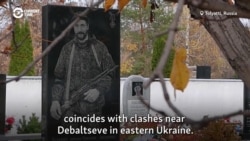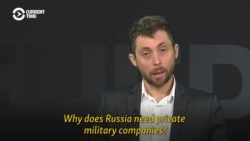In early October 2018, the Ukrainian Security Agency published a list of 206 Russians and other nationals alleged to be members of Vagner, a mercenary group that the Agency claims has fought in eastern Ukraine and Syria as contract employees of the Main Intelligence Directorate (GRU) of the Russian armed forces’ general staff.
The Agency, also known as the SBU, shared with Current Time correspondent Volodymyr Runets the details of its investigation. The SBU claims that it also knows the addresses which the alleged recruits used when registering with the Private Military Company (ChVK) Vagner.
In Russia, Current Time correspondent Yury Baranyuk examined the SBU’s information and tracked down the stories of four alleged Vagner fighters from Tolyatti, an industrial city on southwestern Russia’s Volga River that has ranked among the country’s poorest.
Ukraine
Since 2014, many Ukrainians who fought in Donbas have visited the Military Church in western Ukraine’s Lviv. Nazariy Chigin is one of them. He participated in the 2014 defense of Donbas’ Luhansk airport, where he was seriously wounded and later captured.
As a prisoner, Chigin discovered that separatists were not the only ones who had been fighting him at the front line.
“The Russian soldiers, well, they didn't hide it,” he recalls. “They were guys my age, 25-20, but there also were officers. They did not have officer ranks, but it was obvious from the way the younger men and separatists communicated with them that they were some kind of people in charge.”
Ukrainian intelligence claims that Vagner’s mercenaries have operated since 2014 within eastern Ukraine’s Luhansk region, a once heavily industrialized area which borders western Russia.
The SBU asserts that, though Vagner fighters were first noticed in Donbas -- and subsequently in Syria, Libya, and Central Africa – those who later became the company’s mercenaries also participated in Russia’s March 2014 annexation of Crimea.
“We can see that they crossed the state border. Usually, on ferries from Russia to Crimea, where they participated [in its annexation]. But the division itself, with staff employees, identification numbers, as well as a defined structure, as we know it today, was formed in May 2014 in the Luhansk region,” alleged SBU Chief of Staff Igor Guskov.
Like other Ukrainian government officials, Guskov asserts Vagner is no independent band of mercenaries, but “a specialized unit of the Russian Special Forces,” operating under the Main Intelligence Directorate (GRU) of the Russian Defense Ministry’s General Staff.
Most Russian federal [TV] channels, which usually actively comment on official Ukrainian statements, have ignored the Ukrainian Security Agency’s publication of the list of alleged Vagner members.
Current Time checked the list’s names in the database of Russia’s Federal Tax Service and confirmed that these individuals do exist. They could not be contacted, however, by either social media or phone calls.
According to the SBU, ChVK Vagner has recruited more than 5,000 people at different times. However, the Ukrainian intelligence service claims that, after heavy losses in Syria and in Donbas, the group is experiencing a personnel crisis.
“We can see that at least 20 percent of the people listed [as Vagner mercenaries] have criminal records,” said Guskov, who did not elaborate about his sources. “Based on that, we can conclude that the criteria were lowered for those recruited by Vagner.”
In the past, Guskov continued, the SBU could identify why Vagner rejected some recruits and knew that prospective fighters had to take polygraph tests. “[T]oday, because of heavy losses, Vagner's quality bar for recruits has lowered significantly,” he claimed.
Ukrainian intelligence claims that they will soon publish more information about alleged Vagner members and use their findings in international court cases against the Russian Federation.
Russia
Current Time correspondent Yury Baranyuk tried to verify some of the names of those who have been publicly identified by Russian media as slain Vagner mercenaries. He chose those who lived in Russia’s Samara region, located roughly 800 kilometers southeast of Moscow.
It’s hard to find a well-paid job in this region -- especially in Tolyatti, a city of several hundred thousand, where the labor market depends heavily on AvtoVAZ, the ailing manufacturer of Ladas. A 2015 study by one government-supervised Russian university ranked the city as the poorest in Russia.
Against that backdrop, Vagner’s allegedly generous salaries could prove a draw – the company’s so-called “main” fighters receive 150,000 rubles (roughly $2,230) per month, former Vagner mercenaries have said. As of 2017, that was over five times the size of Samara’s average monthly income, according to official data.
In December 2016, after a year-long investigation, the St. Petersburg website Fontanka.ru published the names of four men from Samara Oblast who had died while allegedly fighting for Vagner in Ukraine: Grigory Mechtanov, Vasily Yurlin, Andrei Schreiner, and Andrei Elmeyev.
The Ukrainian special services released the names of four other individuals, but the connection of all four with Vagner could not be independently confirmed.
Much information about the Fontanka four, however, was available in the public domain.
Grigory Mechtanov
(March 7, 1967 – January 31, 2015)
In 1994, Mechtanov set up his own business, the Turmet travel agency, but his company did not earn profits and he ended up in debt. According to court records, Mechtanov defaulted on a bank loan and none of his relatives wanted to inherit his property to pay off his debt. After his death in 2015, these financial details emerged in a Samara regional court ruling.
Current Time reporters found Mechtanov's father, Gennady, in Tolyatti. He did not conceal the fact that his son had been killed and that he had posthumously received Russia’s Order of Courage. The award is given to individuals who take extraordinary steps to preserve public order, respond to a crime, rescue people in emergency situations or otherwise risk their lives in executing their “military, civil or professional duty.”
But the elder Mechtanov declined to show the award, discuss the reasons why his son was a posthumous recipient, or to speak about the circumstances of his death.
The family’s distress over his son’s death “is just our own pain,” Gennady Mechtanov said. “And the pain is huge. We can't share it with the press.”
The regional site VolgaNews, however, reported in 2015 that Mechtanov posthumously received the Order of Courage “as a participant in military activities” in the Russian republic of Chechnya. The date of his service was not specified.
What official connection, if any, that Grigory Mechtanov had with Russia’s armed forces is unclear. One pro-Ukrainian collective of researchers and journalists, Mirotvorets (The Peacekeeper), has claimed that he fought with pro-Moscow, separatist forces in Donbas and was “liquidated” in Debaltsevo.
Vasily Yurlin
(April 1, 1983 – February 22, 2017)
Some five months before his death in 2017, Vasily Yurlin attempted to go into business as a trader, according to the Russian state registry of legal entities. It appears he may have chosen to take a trip to Syria instead.
One former Tolyatti neighbor confirmed that Yurlin fought in Syria. He did not specify when. "He signed a contract and was fighting in a war zone,” the man said.
Ukraine’s intelligence service believes that Yurlin served in the Russian air force in the early 2000s and was involved in military operations in the Russian republics of Chechnya and Dagestan in the North Caucasus.
As of late 2018, photos of Yurin and his friends wearing the Russian airborne troops’ blue berets and celebrating Airborne Forces Day still existed on his profile on VKontakte, the popular Russian social media network.
Yurlin, though, was buried alongside civilians in Tolyatti’s Primorskoye cemetery. Yet his tombstone is distinct. The large granite stone features a uniformed man with parachutists, set against the background of an airplane and a fading blue beret.
Yurlin’s neighbor claims that he had already resigned from the military when he went to Syria. He traveled there as a civilian, they say. "He worked at the [AvtoVaz] factory, then he quit," the previously cited male neighbor told Current Time. " And then, he was recruited to go to Syria and was killed. There were five of them. They were blown up by a mine.”
Andrei Schreiner
(June 21, 1971 – January 28, 2015)
Tolyatti resident Andrei Schreiner posthumously received Russia’s Order of Courage for fighting in Chechnya. However, the date of his death – January 28, 2015 -- coincides with neither of Moscow’s military operations in that North Caucasus republic. It does correspond with intensive January – February 2015 clashes between Ukrainian troops and separatist fighters near Debaltseve in eastern Ukraine. Government forces ultimately surrendered the town.
Current Time could not confirm the authenticity of a death certificate published by the pro-Ukraine site gruz200.net that placed Schreiner’s death in the Debaltseve region of Donetsk.
Schreiner was buried in the Alley of Heroes, a section for combat personnel, in Tolyatti’s Banykinskoyeskoye Cemetery.
Andrei Elmeyev
(December 31, 1871 – January 28, 2015)
Forty-three-year-old Andrei Elmeyev, another posthumous Order of Courage recipient, was buried next to Schreiner. Their dates of death – January 28, 2015 -- are the same.
As part of a Fontanka.ru investigation, Russian journalist Denis Korotkov reported in 2016 that neither man had a connection with the separatist forces in Donbas nor the Russian military. Nonetheless, the two men were buried alongside soldiers who had died in the line of duty. The tombstones of both feature their Orders of Courage.
Current Time could find neither Elmeyev’s nor Schreiner’s relatives in Tolyatti. The circumstances of their deaths remain unclear.
"A Very Dangerous Trend"
Outside observers believe that alleged ChVK Vagner fighters provide Russia with a critical tactical advantage – the ability to operate covertly in various conflict zones.
While the Kremlin maintains that it has no connection to Vagner, it also has not moved to curtail their activities.
"The state might disapprove of these companies, might be neutral toward them, but would not take any measures to eliminate them if they are acting in accordance with state interests,” commented military analyst Pavel Zolotaryov, the deputy director of the Russian Academy of Sciences’ Institute of the U.S.A. and Canada and a reserve major-general.













Facebook Forum